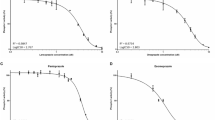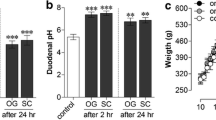Summary
Omeprazole is an inhibitor of gastric H+, K+-ATPase. Although the major proton transport of osteoclast is mediated by a vacuolar-type H+-ATPase which is different from the gastric H+, K+-ATPase,in vitro studies have demonstrated that omeprazole inhibits bone resorption. In this study, the effect of omeprazole on bone resorption was evaluated in patients who had a history of gastric ulcer and were treated with maintenance doses of H2 blocker without any gastric complaints at the study time. H2 blocker administration was changed to omeprazole treatment in the study group and to no treatment in the control group. Urinary excretion of hydroxyproline and calcium decreased after omeprazole treatment in the study group. Serum intact PTH, alkaline phosphatase, osteocalcin, and tartrate-resistant acid phosphatase (TRAP) increased in this group. In the control group, there were not any changes in these parameters. The discrepancy between serum TRAP and urinary excretion of hydroxyproline and calcium in the study group was thought to be due to the suppression of bone resorption by omeprazole, which probably interfered the acidification at resorption lacunae and resulted in the inactivation of TRAP and other lysosomal enzymes. The results of our study suggest the possibility that the specific inhibitors of the osteoclastic proton pump (such as bafilomycins) will more effectively suppress bone resorption and be useful for the treatment of metabolic bone diseases with increased bone resorption.
Similar content being viewed by others
References
Baron R (1989) Molecular mechanisms of bone resorption by the osteoclast. Anat Rec 224:317–329
Blair HC, Teitelbaum SL, Ghiselli R, Gluck S (1989) Osteoclastic bone resorption by a polarized vacuolar proton pump. Science 245:855–857
Arnett TR, Dempster DW (1990) Protons and osteoclasts. J Bone Miner Res 5:1099–1103
Lindberg P, Nordberg P, Alminger T, Brändsröm A, Wallmark B (1986) The mechanism of action of the gastric acid secretion inhibitor omeprazole. J Med Chem 29:1327–1329
Morii M, Takata H, Takeguchi N (1990) Binding site of omeprazole in hog gastric H+,K+-ATPase. Biochem Biophys Res Commun 167:754–760
Bekker PJ, Gay CV (1990) Biochemical characterization of an electrogenic vacuolar proton pump in purified chicken osteoclast plasma membrane vesicles. J Bone Miner Res 5:569–579
Väänänen HK, Kahrhukorpi EK, Sundquist K, Wallmark B, Roininen I, Hentunen T, Tuukkanen J, Loakkakorpi P (1990) Evidence for the presence of a proton pump of the vacuolar H+-ATPase type in the ruffled borders of osteoclasts. J Cell Biol 111:1305–1311
Tuukkanen J, Väänänen HK (1986) Omeprazole, a specific inhibitor of H+-K+-ATPase, inhibits bone resorption in vitro. Calcif Tissue Int 38:123–125
Andersen RE, Woodbury DM, Jee WS (1986) Humoral and ionic regulation of osteoclast acidity. Calcif Tissue Int 39:252–258
Eftradiadis T, Moss DW (1985) Tartrate-resistant acid phosphatase of human lung: apparent identity with osteoclastic acid phosphatase. Enzyme 33:34–40
Clark SA, Ambrose WW, Anderson TR, Terrell RS, Toverud SV (1989) Ultrastructural localization of tartrate-resistant, purple acid phosphatase in rat osteoclasts by histochemistry and immunocytochemistry. J Bone Miner Res 4:399–405
Miller SC (1985) The rapid appearance of acid phosphatase activity at the developing ruffled border of parathyroid hormone activated medullary bone osteoclasts. Calcif Tissue Int 37:526–529
Chambers TJ, Fuller K, Darby JA (1987) Hormonal regulation of acid phosphatase released by osteoclasts disaggregated from neonatal rat bone. J Cell Physiol 132:90–96
Bergman I, Loxley R (1970) The determination of hydroxyproline in urine hydrolysates. Clin Chim Acta 27:347–353
Nussbaum S, Zahradnik R, Lavigne J, Brennan G, Nozawa-Ung K, Kim L, Keutman H, Wnag CA, Potts JT Jr, Segre G (1987) Development of a high sensitive two site immunoradiometric assay for parathyroid hormone and its clinically utility in evaluation of patients with hypercalcemia. Clin Chem 33:1364–1367
Eilon G, Raisz LG (1978) Comparison of the effects of stimulators and inhibitors of resorption on the release of lysosomal enzymes and radioactive calcium from fetal bone in organ culture. Endocrinology 103:1969–1975
Quarles LD, Lobaugh B, Murphy G (1992) Intact parathyroid hormone overestimates the presence and severity of parathyroid-mediated osseous abnormalities in uremia. J Clin Endocrinol Metab 75:145–150
Williams GA, Longley RS, Bowser EN, Hargis GK, Kukreja SC, Vora NM, Johnson PA, Jackson BL, Kawahara WJ, Henderson WJ (1981) Parathyroid hormone secretion in normal man and in primary hyperparathyroidism: role of histamine H2 receptors. J Clin Endocrinol Metab 52:122–127
Brown EM, Garder DG, Windeck RA, Hurwitz S, Brannan MF, Aurbach GD (1979) β-adrenergically-stimulated adenosine 3′,5′-monophosphate accumulation in and parathyroid hormone release from dispersed human parathyroid cells. J Clin Endocrinol Metab 48:618–626
Heath H III (1980) Biogenic amines and the secretion of parathyroid hormone and calcitonin. Endocrinol Rev 1:319–338
Baron R, Neff L, Louvard D, Courtoy PJ (1985) Cell-mediated extracellular acidification and bone resorption: evidence for a low pH in resorbing lacunae and localization of a 100-kD lysosomal membrane protein at the osteoclast ruffled border. J Cell Biol 101:2210–2222
Gluck S (1992) The osteoclast as a unicellular proton-transporting epithelium. Am J Med Sci 303:134–139
Mattsson JP, Väänänen K, Wallmark B, Lorentzon P (1991) Omeprazole and bafilomycin, two proton pump inhibitors: differentiation of their effects on gastric, kidney and bone H+-translocating ATPases. Biochim Biophys Acta 1065:261–268
Lindberg P, Bränström A, Wallmark B, Mattsson H, Rikner L, Hoffman KJ (1990) Omeprazole: the first proton inhibitor. Med Res Rev 10:1–54
Silver IA, Murrills RJ, Etherington DJ (1988) Microelectrode studies on the acid microenvironment beneath adherent macrophages and osteoclasts. Exp Cell Res 175:266–276
Borg KO, Olbe L (1985) Omeprazole—a survey of preclinical data. Scand J Gastroent 20:1–120
Bowman EJ, Sibers A, Altendorf K (1988) Bafilomycins: a class of inhibitors of membrane ATPases from microorganisms, animal cells, and plant cells. Proc Natl Acad Sci USA 85:7972–7976
Author information
Authors and Affiliations
Rights and permissions
About this article
Cite this article
Mizunashi, K., Furukawa, Y., Katano, K. et al. Effect of omeprazole, an inhibitor of H+, K+-ATPase, on bone resorption in humans. Calcif Tissue Int 53, 21–25 (1993). https://doi.org/10.1007/BF01352010
Received:
Revised:
Issue Date:
DOI: https://doi.org/10.1007/BF01352010




